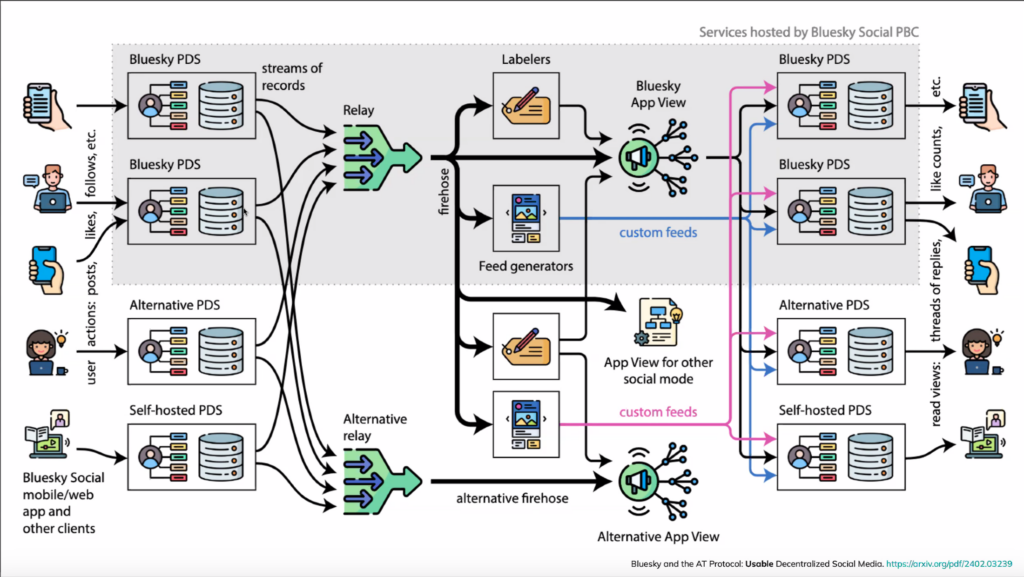Fleeing the hellsite: Mastodon vs Bluesky?
Is Mastodon or Bluesky the best open social media option for those fleeing Elon M*sk’s enshittified ex-Twitter? What are the advantages of each in avoiding this billionaire-capture process happening again? And why can’t we have both?

Even better: can competition regulation further open up today’s social media giants to scrappy, diverse challengers?
The total enshittification of X
It can’t fail to have escaped the notice of most Internet users that the worst predictions about the damage Elon Musk would do to and with his $44bn toy, the service formerly known as Twitter, were if anything understated. But as Cory Doctorow explains:
The problem with social media is that the people we love and want to interact with are being held prisoner in walled gardens. The mechanism of their imprisonment is the “switching costs” of leaving. Our friends and communities are on bad social media networks because they love each other more than they hate Musk or Zuck. Leaving a social platform can cost you contact with family members in the country you emigrated from, a support group of people who share your rare disease, the customers or audience you rely on for your livelihood, or just the other parents organizing your kid’s little league game.
What is absolutely unforgivable at this stage is politicians and political institutions who are still not just posting on X, but are not even using (free) tools like Buffer to cross-post to other, less fascist-adjacent social media, thus encouraging constituents and journalists to stay. And it’s this political-media-voter configuration which give X its “town hall” character. (A friend darkly suggested that currently, it’s more like a beer hall putsch.)
As the USA columnist of that radical left publication The Financial Times said of Musk’s ambitions for X: “Consumers will soon be able to get their social media, bank transfers, AI support and neo-Nazi propaganda all from one platform.”

Free Your Feed from billionaire capture
Musk has made things so bad at X, this is a rare opportunity for some users to coordinate on a sufficient scale to leave alongside many of their existing network members.

Mastodon and Bluesky are two “open” alternatives to X, which have attracted millions of fleeing users. But how can we be sure the same problems won’t happen again once either/both get large enough?
A new campaign, Free Our Feeds (FoF), has been launched to “save social media from billionaire capture” (see also Cory). But there has been some criticism of it on social media (mainly Mastodon), particularly for its apparent focus on Bluesky. For example, Rodrigo Ghedin suggested:
We already have a billionaire-proof social media. One that, on the same day Free Our Feeds appeared passing the hat to do who knows what within Bluesky, took a concrete step to consolidate its shield against capital by announcing a new governance structure, also non-profit, that will remove the final word from the founder and current CEO, Eugen Rochko, within the project.
This was indeed an admirable move by Rochko, and I agree somewhat with some of Ghedin’s other points about the transparency and governance of FoF (which I am sure the FoF team will be working to address).
I also very much agree with Ghedin that “I don’t question the good intentions and good character of those involved in Free Our Feeds and Bluesky”. Full disclosure: I know and admire some of the FoF team, and their work.

Why can’t we have both?
On the broader question of where support is best targeted for the further development of open social media, I agree with FoF’s Robin Berjon: why can’t we have both? 😃 Users can already multi-home across multiple services using third-party apps such as Openvibe (which can integrate Bluesky, Mastodon, Nostr and Threads accounts 👏).
As Robin notes, it’s important to differentiate between the services users see (Bluesky and e.g. Mastodon) and the underlying protocols which enable them (ATProto and ActivityPub). Free Our Feeds itself adds (in its FAQ section):
AT and ActivityPub should not be either/or options. Our vision is that interoperability between open social media platforms is achieved through collaboration. This campaign can organize developer communities, fund product development, support testing that improves bridging and native protocol interoperability.
I’ve written previously about how these networks can also be partially integrated using existing tools, and the benefits that brings. Supporting these types of tools is another goal of FoF.
Comparing Mastodon/ActivityPub and Bluesky/ATProto
[Brief Mastodon overview to come here]
Bluesky posts are stored in Personal Data Stores (PDSes), brought together by a “relay”, labelled for use in content moderation, selected into feeds by “feed generators”, and shown to users by “app views”.

Source: M. Klepman et al. (2024) Bluesky and the AT Protocol: Usable Decentralized Social Media, Proceedings of the ACM Conext-2024 Workshop on the Decentralization of the Internet (CC-BY 4.0)
ATProto has some interesting properties, such as resilience to individual PDS failure, compared to ActivityPub. Robin suggested in a follow-up comment that Ghedin’s post saw “capture-resistance properties in [ActivityPub] that aren’t there”. Prof. Anil Madhavapeddy told me:
The design of ActivityPub bakes in URIs of the hosting server into the protocol, and then signs each message cryptographically as it is sent. This makes it very hard to recover messages if the hosting server disappears as it’s tied to the domain name and the key. It is possible to build up a decentralised key crawling service (see sec 3.1 for an overview of this) that fulfils this function across ActivityPub services, but I’m not aware of one running “for real” across the whole network (since the Mastodon community doesn’t approve of global crawling infrastructure across their network).
UPDATE: many thanks to Bumblefudge for pointing out the ActivityPub technical standard (rather than its implementation by Mastodon) would enable “a self-hosted PDS-style URI scheme [which] would provide credible exit and long-lived URLs”.
As one of the architects of ActivityPub, Christine Lemmer-Webber, noted:
addressing the serious issues of both [protocols] converges on a shared direction: the fediverse needs to adopt content addressing and portable identity (criticisms of Bluesky’s approach to this latter one aside at the moment), Bluesky needs to support a messaging architecture such that participating meaningfully and fully in decentralization does not mean needing to host everything (adopting such a solution will probably mean adopting something that ultimately looks a lot like ActivityPub). And of course, I think both need to move towards supporting privacy and stronger collaboration tools with capability security. While others have argued that these are “different approaches” — and perhaps this is because I am overly ambitious in what I think decentralized networks should do — to me this is because both are not being all they could be. Instead to me it feels that there is a “fixed point” of resolving these issues to iterate towards.
For those who want to dig deeper into the protocol debate, there is a LOT more information from Christine here and here (with helpful engagement from Bryan Newbold, a Bluesky engineer). And the designers of Bluesky explain it in this paper, with the useful illustration above.
In summary (this table is still work in progress; check back for updates!):
| Feature | Mastodon/ActivityPub | Bluesky/ATProto |
|---|---|---|
| Architecture | The “Fediverse” consists of (thousands of) partly-interconnected servers for services such as Mastodon, PixelFed, PeerTube and many other social apps, which provide functionality such as micro-blogging, photo-sharing, video-sharing and many others. | Bluesky as a service is (currently) significantly more centralised than Mastodon, even though ATProto allows some level of decentralisation. It aims to replace ex-Twitter as a “global public square”. There are experiments with other types of services built on top of ATProto, but they are at an earlier stage of development than the Fediverse’s. |
| Custom feeds and moderation | Mastodon does not currently support custom feeds, although they would be technically possible within the service, perhaps with extensions to ActivityPub. Mastodon allows users to block other users, and entire servers. At the server level it allows “defederation”, or targeted disconnection of one server by another, and moderation of posts by server administrators, based on the server’s own moderation rules. | Bluesky supports users to create their own custom feeds, and also choose from a range of moderation services. Unlike most social media, this gives individual users choices over what types of content they want to see recommended to them (where they prefer this to a strictly chronological feed), and to make different choices about what types of content they want to block. Users can also block other users (this is currently a public act), and subscribe to community-driven lists of accounts to block. |
| Starter packs (replace algorithmic recommendations of accounts to follow) | ✅ | ✅ |
| Self-hosting posts (by individuals or smaller organisations) | It is entirely feasible for small non-profit organisations (such as our eupolicy.social) or even individuals to run Fediverse servers, although the latter might struggle to get much visibility for their posts across the whole “Fediverse”. | Bluesky users could host their own Personal Data Stores (the vast majority currently do not). |
| Decentralising infrastructure | Fediverse servers have reasonably low costs. Non-profit organisations (rather than individuals) will probably find volunteers to undertake moderation duties. We need detailed legal analysis of all these services to look at (for example) their GDPR and DSA compliance. These are burdens which fall on Mastodon server operators (useful advice is available.) | Bluesky’s infrastructural components (particularly the “relay” which sees all Bluesky posts, and “app view”, which almost all users are currently using to participate in the service) are significantly more resource-intensive than its PDSes. As Tim Bray notes as part of a useful broader analysis, “assuming that Bluesky keeps growing, this is going to be a big, challenging piece of software to build, maintain, and operate, and the performance of the whole service depends on it.” |
| Account portability | ActivityPub users can move from one server to another, with their existing followers automatically re-following them. This does not (currently) move all their previous posts to their new server, although this would be relatively straightforward from a technical perspective. | Bluesky’s goal of enabling “credible exit” for users is critical to its billionaire-resistance. It has a significantly-smoother ability for users to move between components of the service than Mastodon. But there are still key components which need developing to make this straightforward enough to be sure Bluesky’s generally less-technical users could easily “exit” — in other words, move their accounts en masse if Bluesky PBC (the public benefit corporation running the service) was captured by Elon Musk, techbro crypto investors, or other modern horrors of the social media world 😬 NB Many users were concerned Bluesky PBC has taken investment from Blockchain Capital. These elements include further development of Bluesky’s Decentralised (sic) Identifiers, which are currently still managed by Bluesky PBC for its users. |
| Private features | Mastodon users can choose whether to pre-approve new followers, and limit how far their posts are replicated through the Fediverse. | Almost everything about Bluesky is open by default. Some Bluesky users would like the ability to keep posts limited to followers they have individually approved. They would also like the ability to maintain private lists, and to keep their blocked account lists private to avoid retaliation. Private blocking is something Bluesky has acknowledged as a priority. |
There have also been some interesting experiments with running Bluesky and Mastodon components on Cloudflare, which with its global replicated content distribution network is a very interesting idea.
There is currently disagreement over just how much more expensive a Bluesky relay would be to operate than a typical Mastodon server. Christine Lemmer-Webber implies (see section The costs of decentralizing ATProto) it would realistically cost tens of thousands of dollars annually to run. Bluesky engineer Bryan Newbold suggests it would be much cheaper, perhaps even comparable (Bridgy.Fed developer Ryan Barrett agrees).
It would be possible for relays to forward some fraction of the global feed, but that starts to run into the incoherent-world-view issues which affect ActivityPub. That is an issue for a “global town square”, although less so for smaller communities and many other use cases for ATProto.
Having a second relay run by a non-profit (one of FoF’s goals) would significantly improve the billionaire-resistance of the ATProto world (sometimes called the ATmosphere 😄). And Phil has explained how even an almost-fully-functional app view could run on a tiny Raspberry Pi computer.
Engineer David Buchanan noted recent technical developments “should greatly improve ATproto’s ability to ‘scale down’ — e.g. running a custom appview without having to sync the full network state, and full cryptographic validation of firehose events without storing full repo states”.
In a longer post on these issues Robin Berjon is already drafting, he kindly shared one particular insight in advance with me:
The only reason ActivityPub is decentralised today is because it’s not valuable enough to capture. (And that’s good — it means there’s time to fix the issues before it’s too late!)
But the second, say, Google wants to step in, they can index the whole network and offer much better feeds than any instance — and give AP accounts to all gmail users… Game over.
Mandating algorithmic plurality
Civil society groups are campaigning for “algorithmic plurality” (like Bluesky’s) to be mandated for very large social media platforms — to give users a free choice of third-party recommendation algorithms.
In the EU, this could have been mandated in the EU’s Digital Services Act (DSA) Art. 38. But some other legal route might be possible, perhaps in future via revision of the Digital Markets Act (DMA) Art. 7, or even using the DMA’s existing real-time data portability (Art. 6(9)) for read-only access to a user’s own posts to cross-post them on open social media, and/or FRAND access provisions Art. 6(12) to enable third-party display of posts, if not interaction with them.
Facebook, Instagram, YouTube, LinkedIn and TikTok (and WhatsApp and FB Messenger) have all been designated under the DMA. If only the European Commission would also designate X as a gatekeeper online social networking service 🙄
Legal interoperability requirements also needed
I’m a keen supporter of what FoF, the algorithmic pluralisers, Bluesky and Mastodon are trying to achieve.
I still also think legal requirements for the largest closed social networking services to enable their users (if they wish) to connect to people on other services, and vice versa (aka interoperability), will be essential for the plural social media environment many people wish to see. As Prof. Fiona Scott Morton concluded in a recent review:
Increasing interoperability … would encourage competition on content algorithms, customisation, locality and monetisation. By expanding the scope of interoperability requirements, the DMA could significantly reduce the market power of gatekeepers, provide users with more choice and create opportunities for new social networks – and models for social networking – to emerge. As messaging and social networking platforms continue to converge, extending interoperability standards will best support the continued development of competition in these sectors.
This early-2025 graph could not be clearer:

Facebook, YouTube, Instagram, TikTok, Douyin (Chinese TikTok), SnapChat, and Kuaishou (another Chinese short video service) collectively dwarf ex-Twitter (even if the latter remains influential, thanks to the now-inexplicable ongoing posting by politicians, journalists, and other members of the globalist elite 😉).
Facebook alone has more than five times the monthly-active users of X. Mastodon (with around a million active users) and Bluesky (with roughly 30m total users [1]) are tiny specks by comparison.
Even more to the point: Bluesky’s rapid growth compared to Mastodon is a reminder how important network effects are for successful social media, especially such “global town square” networks (alongside X, TikTok and YouTube — see provisos from Iansiti (2021)).
Services need to grow beyond a certain “tipping point” where they are interesting enough (to a diverse range of potential users) to draw in (lots of) further users [2].
Conclusion
Opening up these mega-social networking services via interoperability requirements could have such a big impact for social media pluralism, by enabling new services to enter the market and grow rapidly without having to first overcome this “tipping point” chicken-and-egg obstacle [3, 4].
An excellent complement would be mandating such mega-services offer their users a choice of third-party recommendation and moderation tools.

As the must-read Fediverse Report noted regarding Meta’s Threads service, which is partly — and increasingly — interoperable with the Fediverse:
Meta is a company with an incredible amount of resources, and employs highly talented people. When the company feels competitive pressure, they are capable of moving incredibly quickly. Threads now feels competitive pressure from Bluesky, and it took Threads less than two weeks to build Starter Packs, Custom Feeds, a better search tool, shift stance on default feeds, and mimic Bluesky’s UI. That is all to say: the speed at which Meta delivers a product is deliberate. It is not an accident, and Meta is certainly not a company that is resource-constrained. If Meta wants to do something, it will do something.
We are so close to legal requirements for social media interoperability for the largest closed platforms. The EU has already imposed them on WhatsApp and Facebook Messenger, under its Digital Markets Act (Art. 7) (although sadly not iMessage 😒). It must review extending this to social networking services by next year (Art. 53(2)). Other major jurisdictions, including the UK, Brazil and Australia, are developing similar regulations.
Interoperability requirements might also emerge through stricter enforcement of data protection laws such as Europe’s GDPR, blocking transfers of personal data to countries that will not give it ‘adequate’ protection, except where users have explicitly chosen to connect to users of interoperable services in such jurisdictions.
Mandatory interoperability support for the largest closed platforms seems to me the prize 🏆 we should collectively keep our eyes on for increasing the diversity of social media, alongside other beneficial initiatives such as Free Our Feeds and algorithmic plurality, and supporting the growth of the Fediverse and Bluesky.
Acknowledgments
Many thanks to Marwan Fayed, gateklons, Robin Berjon, Anil Madhavapeddy, Ignacio Castro, and my anonymous competition lawyer friend for thoughts on earlier drafts!
[1] I can’t find any Bluesky MAU figures, and the Bluesky bump from X exodus is slowing down, data shows. Here is some data. Bluesky currently has around 2m daily “likers” and 1m daily posters (h/t Anil!)
[2] In competition economics terms, it may well be easier for specialist competitors (like Snapchat and TikTok) to initially “target smaller subsets of users and attain a smaller critical mass”, especially with tightly-knit communities they can target sequentially, then build on that growth later (Iansiti (2021, p.7)).
And yet, Facebook has overcome numerous obstacles — from repeated privacy outcries to initial difficulties adapting to the rise of smartphones — to remain the world’s biggest social networking service, with the market capitalisation of parent Meta currently $1.87tn. I think we need more nuanced analysis of actual user multi-homing and switching behaviour in existing social networks (where bridging/other forms of interoperability already play some role).
[3] A common objection from Industrial Organisation economists (who have a… slightly unhealthy grip on competition policy) is this will reduce the incentive for existing platforms to develop further, and for users of existing platforms to switch to new services. But given the market power of the social media incumbents, I’d argue the former is anyway limited. (Even Google has tried and failed multiple times to compete for rather than on the market to overcome these network effects, along with making a raft of other mistakes.)
Making it easier for users of X and the other “magnificent 7” social media services larger than it to more easily experiment with new services via partially interoperable multi-homing will both help those new services develop, and over time potentially encourage those users to switch. Iansiti (2021, p.3) concluded: “multi-homing may weaken user reliance on a given platform, intensify competition, and force innovation by even large incumbents. These effects are particularly pronounced amongst social networks and tend to reduce the effective strength of network effects, enabling entry and competition.”
Multi-homing itself however is not enough. As Scott Morton noted: “there is work involved in creating a post that includes a combination of image, video and text elements, or which exists in contextual relation to another post on the same platform, and users want to reach many of their friends at once with the same content. Users do not want to repeat the work of describing a holiday or uploading photographs across several social networks, and yet they want all their friends to know about their holiday. The user therefore wants to create and post their content once only on the monopoly network. This unwillingness to multihome means entrants cannot realistically gain traction and therefore the competition that would be beneficial for users and advertisers is limited. An interoperability rule for personal social networks could improve outcomes in this respect.”
As a competition lawyer friend told me privately (with permission to post): “I think the incentives are mixed for big platforms today. On the one hand enshittification is real. On the other incentives to innovate can still exist when a network is already dominant, but usually related to trying to increase users’ usage time vis-à-vis other types of services, or expanding the company’s ecosystem, neither of which is the level of innovation incentive you’d see from genuine competitive pressure” 💯
[4] One constraint on Mastodon’s growth has been its deliberate “anti-viral” design, which prioritises user safety in small-world communities. Even now the main Mastodon web interface does not allow the “Quote Posts” which are a popular feature of X, Bluesky and other social networking services. The platform has also deliberately avoided easy search indexing, to limit the ease with which non-connected users can discover each others’ content, “in order to reduce the risk of abuse by people searching for controversial terms to find people to dogpile.”
Both these issues are currently being addressed by the non-profit behind the service in a way which maintains user safety, while enabling this functionality for those who explicitly want it.

One thought on “Fleeing the hellsite: Mastodon vs Bluesky?”